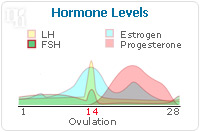
Few people understand the complexity of the estrogen hormone and the role it plays, because few people need to be familiar with that sort of information.
Estrogen plays a vital part before, during, and after menopause. Therefore, understanding even just the basics about estrogen, what it does, and how the different levels will affect you, will allow you to understand why your body is doing what it is doing and help you to control its effects.
What Is Estrogen?
- Estrogen is the hormone that is mainly responsible for regulating menstrual cycles and it promotes the development of female sexual characteristics; it affects the reproductive tract, prepares the breast glands for future milk production, and keeps our bones and skin in good condition.
- Estrogen is made up of three different types of hormone: estrone, estradiol, and estriol.
- The majority of estrogen is made up of estradiol, which is produced in the ovaries. The adrenal glands produce estrone and the liver produces estriol. All three are steroid based hormones.
Estrogen Levels in the Premenopausal Stage

- Premenopause is the phase between your first period and your last. It typically lasts from early teen years to early 40's, but it will differ for every woman.
- On day one of your period, estrogen levels are low from the previous cycle, signaling the breaking down of the lining of the uterus which is shed from the body; this is why you bleed.
- It is from days five to 12 of your monthly cycle that estrogen levels rise, lining the uterus in preparation of pregnancy. Estrogen levels will drop automatically during ovulation, from days 13 to 15, but will rise again after ovulation so that the womb is ready for the egg once it has left the ovary.
- On day 25, if the egg hasn't become fertilized by a sperm then estrogen levels drop. The egg will be broken down and shed with the next cycle.
Estrogen Levels in the Perimenopausal Stage
- Perimenopause is the stage which signals the end of the reproductive system and comes before menopause. It is usually the stage in which women start to experience menopausal symptoms.
- This stage usually lasts between 2 and 10 years and typically starts in the early 40's, although it can begin earlier than this.
- Estrogen levels begin to fluctuate. If ovulation fails one month, but estrogen is still produced then the lining of the uterus gets thicker, resulting in a heavy bleed. Alternatively, some cycles may see little estrogen being produced in the first place, meaning a period ceases or is very light. Irregular periods become commonplace.
Estrogen Levels in the Menopausal Stage

- Menopause is said to have occurred when a woman hasn't had a period for a year. It will come at a different time for each woman.
- On average, menopause kicks in at around the age of 51.
- The year leading up to menopause will make the levels of estrogen become very imbalanced and can even result in excess estrogen levels, because of the lack of progesterone in the body. All menopausal symptoms can be caused by the imbalance of hormones, but no person is likely to suffer from all of them.
Estrogen Levels in the Postmenopausal Stage
- By the time you reach postmenopause, most of the enduring of menopausal symptoms is over.
- Estrogen is still produced but in much smaller quantities.
- The continuous lack of estrogen does mean that new concerns arise. Postmenopausal women are at greater risk of more serious health problems.
More Information about Estrogen
This information is to find out the importance of knowing about your body and the hormones that run through it. To find out more information about estrogen or ways to increase estrogen levels, then follow the link below.